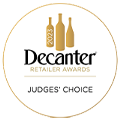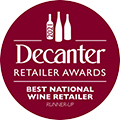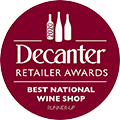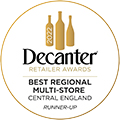On day three of our Bordeaux trip, we said farewell to the Left Bank and moved eastwards to the Right Bank appellations of Pomerol and Saint-Émilion.
Initial reports from the region suggested that early ripening Merlot had been the outstanding performer here, whilst Cabernet Franc had also blossomed throughout 2022 ‒ something we confirmed as we travelled through the heartland of these celebrated varietals, sampling the wines firsthand and discussing the vintage as a whole.
The foundations of this remarkable vintage were laid out long before the September harvest of 2022. A comparatively wetter 2021/2022 winter in Saint-Émilion and Pomerol compared with the Médoc would go on to prove invaluable, but the earlier part of the year was notable for the significantly warm and dry conditions. Many producers suggested the vines experiencing this lack of rainfall at the beginning of the year intuitively reduced their water intake, perhaps foreseeing the dry conditions to come.
Budbreak occurred in late March for both appellations and despite the arrival of frost in early April, it was mercifully brief and châteaux reported very little effect on their production. As temperatures increased, flowering took place in mid to late May, followed by hot and dry growing conditions throughout June to September when Bordeaux experienced frequent and prolonged heat waves (with temperatures getting as high as 40°c). Indeed, Edouard Moueix informed us that the region had experienced the highest recorded sunshine hours between June and September since 1949 ‒ a total of 1175 hours!
Fortunately, there was some respite from the drought as showers in late June and July gave the vines some much-needed nourishment, staving off the worst effects of hydric stress. Of the two communes, it was Pomerol which felt the brunt of the torrid conditions as the modest winter rainfall fell mainly on the vineyards of Saint-Émilion. Significantly, and unlike recent hot vintages, nighttime temperatures across the Right Bank were sufficiently cool enough to enable the vines to rest and retain good acidity levels in the grapes.
When harvesting finally took place, it did so in perfect weather conditions, starting with Merlot being picked in early September and finishing off with Cabernet Franc and Petit Verdot in mid-September. The absence of severe frost, coupled with consistent warmth and a lack of disease, led to healthy thick-skinned grapes, rich in tannins and concentrated juice.
Pomerol
A year where Merlot shone. The near-perfect growing conditions resulted in wonderfully aromatic wines, deep in colour, plush and sumptuous in style but with no shortage of round tannins. Early concerns about acidity levels were largely pacified as we experienced freshness and vibrancy throughout many wine samples. The wines of the plateau stood out this year, where the moisture-retaining clay soils proved crucial, whilst the surrounding gravel and sandy soils faired surprisingly well despite their free-draining properties. In a commune which produced many superb wines this year, in the running for the best must be Vieux Château Certan ‒ a glorious wine which brought smiles to the faces of all who tasted it. Impressive and great value for money, Château Domaine de L’Eglise, is fast becoming a stalwart of Tanners’ Pomerol listing ‒ sumptuous and fleshy with oodles of plum and berry fruit, this is sure to win over a legion of new fans.
Saint-Émilion
There was a lot to like here. The larger and more terroir diverse of the two right bank communes, Saint-Émilion was arguably the more consistent in quality. Understandably, Château Cheval-Blanc will take the plaudits and it is a truly great wine, but there are many ‘lesser’ known names that deserve attention. Château Canon-la-Gaffelière was luxuriant with notes of summer fruit crumble, cracked pepper and salivating freshness. Château Valandraud won us over with its big, juicy and powerful style. Château Pavie-Macquin was a personal favourite, with an inky and aromatic character, layered with masses of bright fruit. Of course, any mention of this commune isn’t complete without a reference to Château Figeac ‒ promoted to Grand Cru Classé A in 2022, the exotic nature and energy of this wine was outstanding, showing great complexity, it was a sheer joy to taste.
Beyond Pomerol and Saint-Émilion, there are plenty of great value wines for the canny buyer to look out for. From the Franc-Côtes de Bordeaux, the ever-dependable Château Puygueraud rouge is perhaps the best ever, with masses of satisfying crunchy black fruit and a complexity that belies its origins. From another ‘lesser’ commune, Lalande-de-Pomerol, Cháteau de Bel-Air punches well above its weight delivering a sumptuous well of refreshing, juicy black and red fruit. A real find, and a welcome addition to our list. From Lussac-Saint-Émilion, longtime favourite Château du Courlat, Cuvée Jean Baptiste shows a wealth of plum and damson notes and a density which will keep its legion of fans very happy. An honourable mention has to go to Château Montlandrie; this excellent Castillon-Côtes de Bordeaux shows the quality coming out of this region. A fruit bomb of a wine, its generosity of fruit and power were irresistible and being nicely structured, it should mature well.
It wasn’t all plain sailing, however, despite a broadly positive response, it would be over-simplistic to suggest every wine we tasted had hit the mark. Many producers were candid enough to admit that given the challenges they faced, they really had no idea how these wines were going to turn out. Thankfully, on the evidence of our visit, there were more hits than misses.
Is the Right Bank superior to the Left this year? Possibly, but I think a better question would be, has the Right Bank produced truly great wines? Unquestionably so. How? From the outset, winemakers were keen to emphasize the vintage was a ‘picture of the terroir, not the climate’, specifically the success of older, deep-rooted vines in harnessing the water reserves held in the clay and limestone soils. A further contributing factor lies in the winery. It became clear that only those Right Bank wineries with the necessary skills, technology and experience were able to take the opportunity to produce great wines in this climatically unique vintage. If the growing conditions of 2022 are a sign of things to come, on the evidence of our visit, it seems the Right Bank and Bordelais are in general learning to successfully evolve their practices and up for the challenges ahead!
































